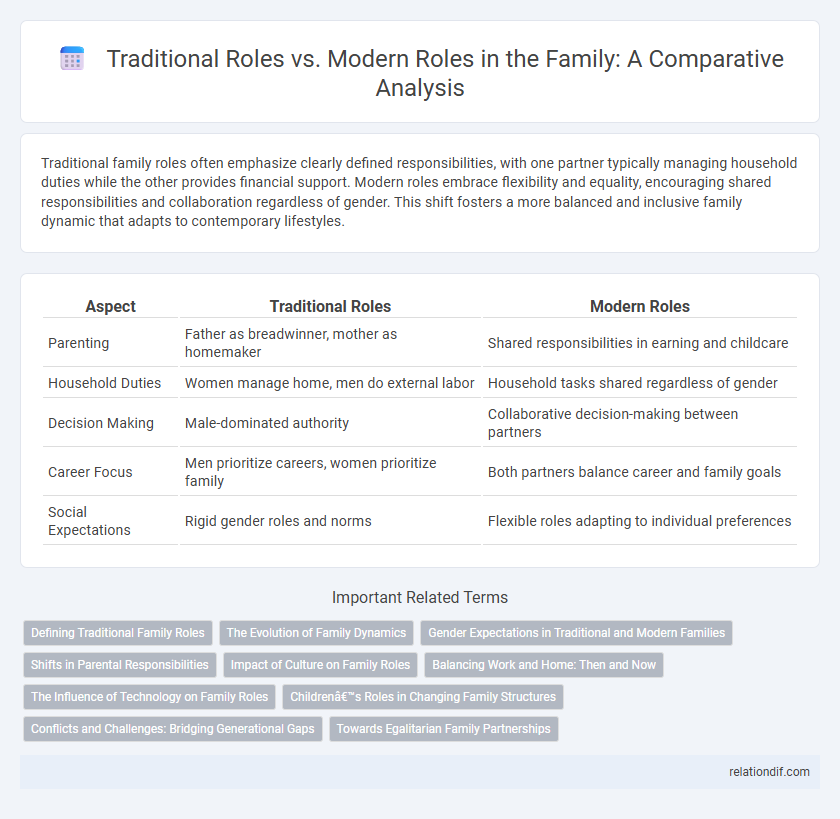Traditional family roles often emphasize clearly defined responsibilities, with one partner typically managing household duties while the other provides financial support. Modern roles embrace flexibility and equality, encouraging shared responsibilities and collaboration regardless of gender. This shift fosters a more balanced and inclusive family dynamic that adapts to contemporary lifestyles.
Table of Comparison
| Aspect | Traditional Roles | Modern Roles |
|---|---|---|
| Parenting | Father as breadwinner, mother as homemaker | Shared responsibilities in earning and childcare |
| Household Duties | Women manage home, men do external labor | Household tasks shared regardless of gender |
| Decision Making | Male-dominated authority | Collaborative decision-making between partners |
| Career Focus | Men prioritize careers, women prioritize family | Both partners balance career and family goals |
| Social Expectations | Rigid gender roles and norms | Flexible roles adapting to individual preferences |
Defining Traditional Family Roles
Traditional family roles typically emphasize clearly defined responsibilities, with men often serving as primary breadwinners and women as caretakers and homemakers. These roles are rooted in cultural norms and historical practices that assign specific duties based on gender. Understanding traditional family roles helps contextualize the evolving dynamics in modern households where responsibilities are more fluid and shared.
The Evolution of Family Dynamics
Traditional family roles often designated men as primary breadwinners and women as caregivers, reflecting historical social and economic structures. Modern family dynamics show increasing flexibility, with shared responsibilities in child-rearing, household tasks, and financial support becoming more common. This evolution supports diverse family models that emphasize equality, communication, and adaptability in balancing work and personal life.
Gender Expectations in Traditional and Modern Families
Traditional family roles typically emphasize distinct gender expectations, with men often seen as primary breadwinners and women as homemakers and caregivers. Modern families increasingly embrace fluid gender roles, promoting shared responsibilities in childcare, household duties, and career pursuits regardless of gender. This shift reflects broader cultural changes toward gender equality and individual choice within familial structures.
Shifts in Parental Responsibilities
Shifts in parental responsibilities reflect a move away from traditional roles, where mothers primarily managed home and childcare while fathers focused on financial support. Modern family dynamics emphasize shared responsibilities, with both parents actively involved in caregiving, household duties, and career pursuits. These changes enhance family cohesion and promote gender equality within parenting roles.
Impact of Culture on Family Roles
Cultural values profoundly shape family roles, with traditional societies often emphasizing clearly defined responsibilities based on gender and age. Modern roles increasingly reflect egalitarian principles, influenced by globalization and shifting cultural norms that promote shared responsibilities and flexibility. These cultural shifts impact parenting, household duties, and decision-making dynamics, redefining family interactions and expectations.
Balancing Work and Home: Then and Now
Traditional family roles often emphasized clear divisions, with one partner primarily responsible for income and the other for domestic duties, limiting flexibility in balancing work and home life. Modern roles increasingly promote shared responsibilities, enabling both partners to engage in career development while actively participating in household management and child-rearing. Advances in technology and evolving social norms support more dynamic arrangements, fostering improved work-life balance and gender equality within families.
The Influence of Technology on Family Roles
Technology reshapes family roles by enabling remote work and flexible schedules, allowing parents to balance career and caregiving more effectively. Digital communication tools foster closer connections among family members despite physical distances, transforming traditional interaction patterns. Smart home devices and online resources redistribute household responsibilities, promoting shared duties and evolving family dynamics.
Children’s Roles in Changing Family Structures
Children's roles in changing family structures have evolved significantly from traditional expectations centered on obedience and household responsibilities to modern roles emphasizing emotional support and active participation in family decision-making. In contemporary families, children often balance educational pursuits with contributing to family well-being, reflecting shifts toward shared responsibilities and autonomy. Research highlights that these evolving roles influence children's social development and resilience in diverse family dynamics.
Conflicts and Challenges: Bridging Generational Gaps
Traditional family roles, often defined by clear gender-based responsibilities, clash with modern, more egalitarian expectations, creating conflicts that challenge communication and cooperation across generations. These differences can lead to misunderstandings about responsibilities, respect, and decision-making authority within the household. Bridging generational gaps requires open dialogue, empathy, and mutual adjustment to harmonize expectations and foster family unity.
Towards Egalitarian Family Partnerships
Traditional family roles often assigned distinct responsibilities based on gender, with men as breadwinners and women as caregivers, limiting individual freedoms. Modern family dynamics increasingly embrace egalitarian partnerships where household duties, child-rearing, and financial responsibilities are shared equitably between partners. This shift toward equality fosters stronger communication, mutual respect, and adaptability within the family unit.
Traditional roles vs Modern roles Infographic

 relationdif.com
relationdif.com